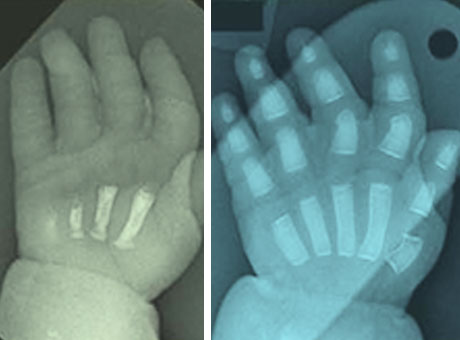
At the beginning of the study, one patient’s hand has almost no visible bone in an X-ray (left). After 24 weeks of treatment, substantial bone formation is visible in the same hand (right).

At the beginning of the study, one patient’s hand has almost no visible bone in an X-ray (left). After 24 weeks of treatment, substantial bone formation is visible in the same hand (right).
Physicians at the School of Medicine, working with Shriners Hospital for Children and other institutions, have identified a promising new treatment for a rare and sometimes life-threatening bone disorder that can affect infants and young children.
Known as hypophosphatasia, the condition upsets bone metabolism, blocking important minerals such as calcium from depositing in the skeleton.
In the March 8, 2012, issue of the New England Journal of Medicine, researchers report that at one year of treatment with a new compound, patients with the most severe forms of hypophosphatasia showed greatly improved symptoms, including increased bone strength, better breathing and improved motor development.
“This was a small trial, but we were thrilled to see these results,” says first author Michael P. Whyte, MD, professor of medicine, of pediatrics and of genetics, who treats patients at Shriners Hospital. “From our experience with studies in mice, we had high hopes. But I think the outcome thus far is beyond anything we had expected.”
At one year of treatment with a new compound, patients with the most severe forms of hypophosphatasia showed greatly improved symptoms.
Hypophosphatasia varies greatly in severity. Its mildest forms may not become apparent until adulthood, and sometimes it may only affect teeth. But in childhood and especially infancy, it can lead to bone weakness, known as rickets. In its most severe forms, hypophosphatasia can lead to death by respiratory failure and has been estimated to occur in about one in 100,000 births. But this number varies worldwide.
“When the condition is extremely severe, a baby may be born with almost no visible bones in an X-ray,” says Whyte, also the medical and scientific director of the Center for Metabolic Bone Disease and Molecular Research at Shriners Hospital. “If an infant has fractured or very thin ribs, the thorax is not going to work properly and respiration is compromised. Together with profound muscle weakness, respiratory lethality is a frequent consequence.”
Hypophosphatasia is caused by a mutation that impairs an important protein, an enzyme called alkaline phosphatase, which then can’t break down chemicals as it should, thereby blocking calcium and phosphate crystals from building normal bone.
The experimental treatment used in this study, ENB-0040, is a manufactured form of normal alkaline phosphatase, but enhanced so that it is targeted to bone.